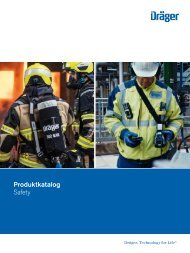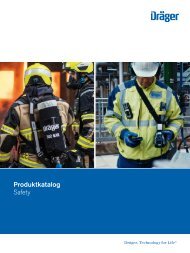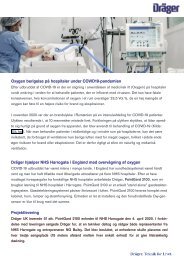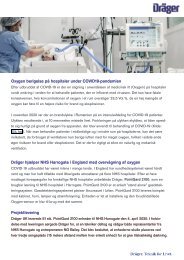Carcinogenic Substances at Work
Create successful ePaper yourself
Turn your PDF publications into a flip-book with our unique Google optimized e-Paper software.
ETHYLENE OXIDE<br />
ETHYLENE OXIDE<br />
C 2 H 4 O<br />
WHAT IS ETHYLENE OXIDE?<br />
Ethylene oxide is a gaseous, colourless<br />
substance th<strong>at</strong> smells like ether <strong>at</strong> toxic<br />
levels. 1,2 It is used in the manufacture of<br />
antifreeze, textiles, solvents, adhesives and<br />
pharmaceuticals.<br />
A primary use of ethylene oxide is as a<br />
chemical intermedi<strong>at</strong>e in the manufacture of<br />
ethylene glycol. 2 More than 40,000 workers<br />
in the European Union have potentially been<br />
exposed to ethylene oxide. 2<br />
GHS02<br />
GHS06<br />
GHS04<br />
GHS08<br />
ETHYLENE OXIDE: FLAMMABLE, TOXIC,<br />
AND HAZARDOUS TO HEALTH<br />
Danger of explosion: Ethylene oxide is<br />
extremely flammable, chemically unstable and<br />
may react explosively in the presence of an<br />
ignition source, even without oxygen. 1<br />
H220<br />
H230<br />
H280<br />
H331<br />
Extremely flammable gas<br />
May react explosively even in<br />
the absence of air<br />
Contains gas under pressure;<br />
may explode if he<strong>at</strong>ed<br />
Toxic if inhaled<br />
Acute effects and early symptoms of exposure<br />
to ethylene oxide include: eye pain, sore<br />
thro<strong>at</strong>, difficulty bre<strong>at</strong>hing, blurred vision,<br />
dizziness, nausea, headache, convulsions,<br />
blisters, vomiting, coughing, increased risk of<br />
miscarriage in females, testicular degener<strong>at</strong>ion<br />
and reduced sperm concentr<strong>at</strong>ion in males.<br />
Prolonged exposure may cause leukaemia,<br />
lymphoid or breast cancer. 2<br />
Caution: Ethylene oxide has a low boiling<br />
point! The main route of exposure is thus<br />
inhal<strong>at</strong>ion in gaseous form, as an aerosol, or<br />
vapour. Special respir<strong>at</strong>ory protection filters<br />
are necessary.<br />
The dangers of ethylene oxide to the human<br />
body and production equipment is described<br />
by the H-st<strong>at</strong>ements enshrined in GHS/CLP<br />
regul<strong>at</strong>ions. They are intern<strong>at</strong>ionally valid.<br />
H315<br />
H319<br />
H335<br />
H340<br />
H350<br />
H372<br />
Causes skin irrit<strong>at</strong>ion<br />
Causes serious eye irrit<strong>at</strong>ion<br />
May cause respir<strong>at</strong>ory irrit<strong>at</strong>ion<br />
May cause genetic defects<br />
May cause cancer<br />
Causes damage to organs through<br />
prolonged or repe<strong>at</strong>ed exposure<br />
CAUTION ETHYLENE OXIDE<br />
CAUSES CANCER!<br />
Ethylene oxide is a carcinogen (classified as<br />
group 1 by IARC) which may cause leukaemia,<br />
lymphoid and breast cancers. L<strong>at</strong>ency period<br />
between exposure and ethylene oxide-rel<strong>at</strong>ed<br />
cancer varies between 9 and 20 years. 2<br />
16 | 33

















